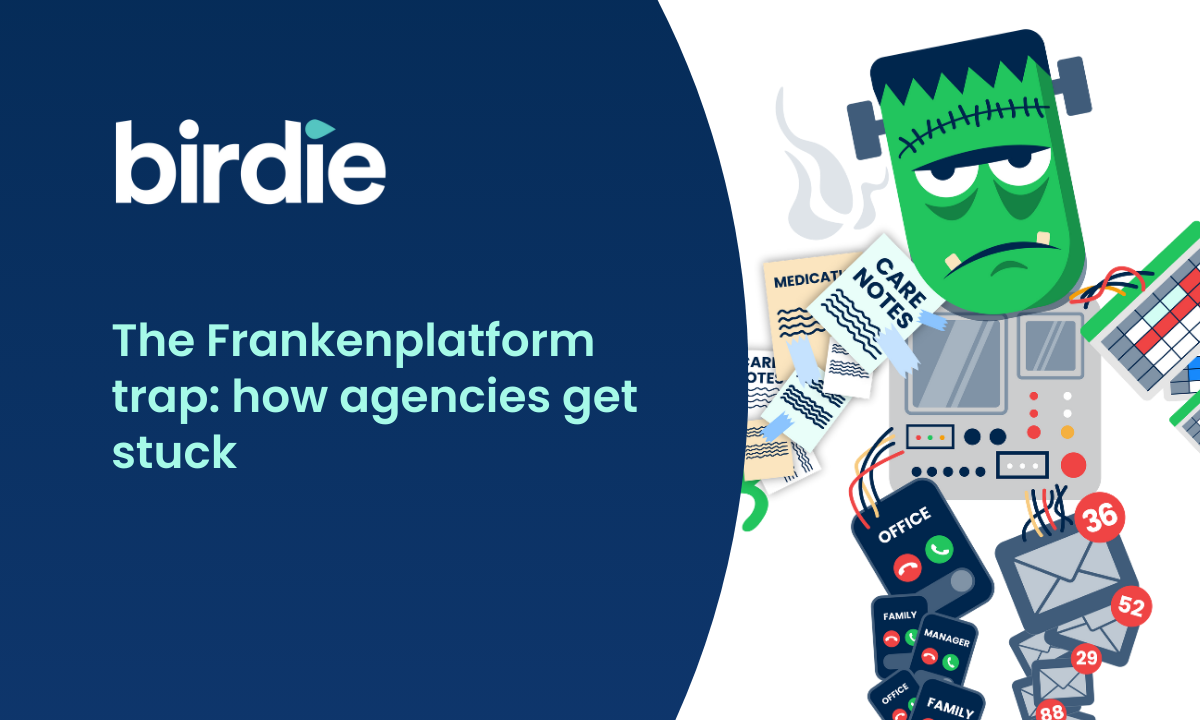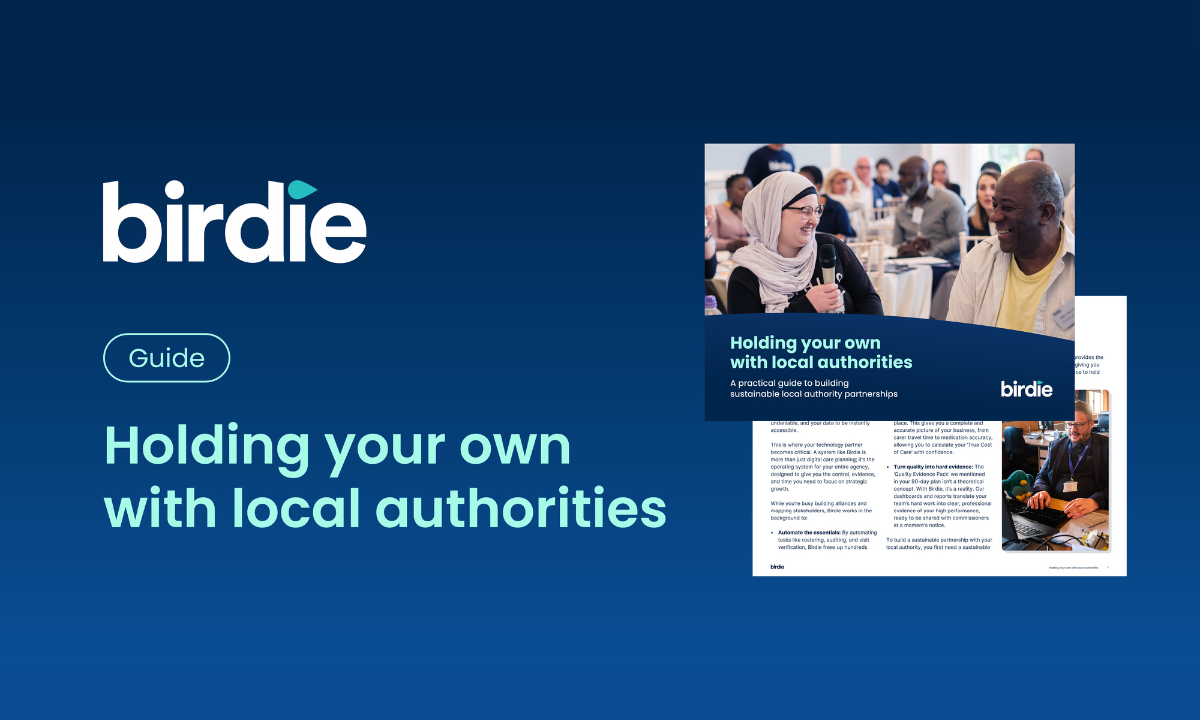Table of contents

At Birdie, we want to help care agencies succeed in all areas of their business. In a recent survey we undertook, over 80% of those who responded told us that their greatest challenge as a home care agency was recruiting staff. We know that recruitment can be difficult, and in times of crisis, it’s harder than ever.
The impact of coronavirus propelled us into action and we made it our mission to speak with experts, compile research and as a result we pulled together a comprehensive eBook, that you can download below.

It’s full of our learnings, practical tips on recruiting faster, activities for you to complete and downloads for you to use and guide your recruitment process. Plus it's all collated from research provided by experts like Neil Eastwood, CEO and Founder of Care Friends, who shared his learnings on referral programmes with us when we welcomed him to a live webinar, plus practical advice from our partner agencies and up to date information and strategies from trusted sources.
Here’s a quick look at what to expect from the eBook and some of the top learnings and ideas from inside…
How to identify your needs
In challenging times, you might find yourself trying to recruit as quickly as possible to plug the gaps. While this may provide some short term relief, the last thing you need is to find yourself in the same position a couple of weeks later, if a last-minute recruit leaves their role. So how can you ensure that not only can you save time - so you can recruit faster - but that you recruit the right people and keep them with you?
Step 1: Assess your business need
Firstly, you need to understand why you need new recruit(s). In the case of a crisis, it may be that you only need a temporary solution or perhaps volunteers could help you manage. We’ll discuss temporary staff and volunteers later, but for now, start with mapping your business needs.
Step 2: Assess the job vacancy
Once you know your business capacity and the gaps you need to fill it’s time to think about the individual roles that will help you get there.
Step 3: Map your values:
Being able to fulfil tasks within a job is only 50% of what you should look for in a candidate. The other 50% lies within their values.
In a crisis, you may be tempted to skimp on the values-based-recruitment, but spending just a little extra time on mapping your ideal candidate will really help you recruit more efficiently. In a crisis, you need your staff to stay with you as long as possible, so this part is really important. This process doesn’t have to take a long time - we’ve already listed a few starter questions for you below. It’s also worth thinking about the kinds of questions you’ll ask in an interview to try and match your applicants with the values you’re looking for.
Step 4: Engage your current workforce
In a crisis, you need to fill shifts, fast. Sometimes, the quickest way to do that is to lean on the staff you currently have to help you plug the gaps. It probably won’t be a permanent solution, but it’ll help you keep running at full capacity until you hire a new staff member. You should also lean on your staff to help reach their networks, but we’ll talk more about that later.

Getting the right people to apply
Before you create your job advert and start to post it on job boards or social media platforms, you need to make sure that it’s speaking to the right people. Making a few tweaks can save your lots of time in the long run, by reducing the likelihood of receiving applications from unsuitable candidates.
Think about your advert structure and ensure your title stands out
We have loads of ways to do this outlined in our free eBook, download it here.
Make the rest of your ad digestible
You need to find a balance between telling your story and connecting with applicants on a personal level, and making sure your advert is easy to skim read and digest. Sounds impossible, but we promise with a few tweaks to your current ads, it’s easy.
Make the next steps clear
Every applicant wants the same thing from a job ad. To be able to apply.
This may sound a little silly, but all too often Calls to Action (CTAs), (which may be an ‘apply now’ link, an email address or the next steps required) are hidden within a job advert.
If possible, use a brightly coloured button, or separate your email address clearly so that applicants can apply. If an applicant struggles to find how to apply, they may abandon the process entirely.

Think outside the box
Research undertaken by Neil Eastwood shows that before COVID-19 over a quarter of care workers came from retail and office backgrounds before working in the care sector. So, when it comes to looking for an expanded talent pool, make sure to look beyond the care industry and lean on your current employees to help you source the right people from alternative backgrounds.
Use a referral scheme
Employee referral programmes are your secret weapon when it comes to hiring the best staff but they can be a hassle to administer and difficult to keep top-of-mind with staff. Using a platform like Care Friends, a brand new app from Neil Eastwood, Author of Saving Social Care, is a great idea - and we explain this in full detail in our eBook, but, by using a referral platform you can expect to:
Attract passive candidates
Passive candidates are not necessarily better than active candidates, but they make up a whopping 75% of the available market.
Create brand advocates
Employee referral programmes also turn employees into brand advocates. If someone is talking to a friend about a job opening, they are sending the message that your company is a great place to work, which is invaluable in a crowded market.
Save money
Employee referral programs help you save money you might have spent on advertisements, agency fees or recruiter commissions. You may have to invest a little into the scheme in the beginning, and be sure to invest into incentives to keep staff engaged, but employee referrals have been proven to produce the highest ROI of any sourcing method. Plus, as referred employees are faster to hire, you'll save money on internal labour costs or outsourcing.
Save time
In a crisis, the last thing you want to do is waste time.
Not only will an employee referral scheme offer higher performing staff, the research proves that you’ll have fewer no shows (with Care Friends, less than 10% of referred applicants are a no show, compared with over 50% normally) and those you do hire will stay longer.
Statistics also show that traditional hiring methods such as posting job ads, combing career sites and retaining an outside recruiter can take up to 55 days from start to finish. Employee referral programs, however, can reduce your hire time significantly. Down to 29 days in fact.
Fast track your process
In a crisis, speed is your best friend in recruitment. To find out how you can use the steps we’ve outlined above and drastically reduce the time it takes to hire, download our eBook!

At Birdie, we want to help care agencies succeed in all areas of their business. In a recent survey we undertook, over 80% of those who responded told us that their greatest challenge as a home care agency was recruiting staff. We know that recruitment can be difficult so we've done the legwork for you. We've spoken with experts, compiled research and created useful articles, eBooks and webinars to help you. Explore this page to find the right resources to help you - from writing your job advert to implementing an onboarding process, we've got it covered. Explore our other content below:
How to advertise your care vacancy to attract the best carers
How to hire exceptional carers
Do you need a care recruitment agency?
10 care industry recruitment challenges and how to solve them
Carer Interview Questions: What Should You Ask?
Values-Based Recruitment Framework
Your Homecare Staff Retention Plan
Social Care Recruitment - 5 Tips For Success
Hired: Your complete guide to recruiting care staff
Practical advice for recruiting carers during the crisis
Even on a good day, being a carer has its challenges. To make life easier for your team, make sure you use the right digital tools to streamline their day and ease their workload. Adopting digital processes, including record-keeping and eMAR, can eliminate the need for paper trails and help free up the carer’s time so they can deliver the outstanding care your clients deserve. Using digital systems in this way shows candidates that you value their time and do all you can to reduce workload where possible. Find out more about the digital tools that can help your business here.
Want more like this? Follow Birdie on Twitter, Facebook and LinkedIn.
Oh, and if you’re interested in learning more about what we do here at Birdie and how we can help you improve your agency, you can find everything you need to know, here.
Published date:
June 19, 2020
Author:
Emma-Lee Curtis

















.svg)